| Image search results - "monogram" |

One nummus
Unknown monogrammeRugser
|
|
![Filename=monogram_1[1].jpg
Filesize=39KiB
Dimensions=749x346
Date added=Nov 22, 2004 monogram_1[1].jpg](albums/userpics/10006/thumb_monogram_1%5B1%5D.jpg)
One nummus
Recimer - Libius Severus
RIC X, Rome 2715.Rugser
|
|

One nummus
Unknown monogrammeRugser
|
|

One nummus
Unknown monogrammeRugser
|
|

One nummus
Unknown monogrammeRugser
|
|

One nummus
Unknown monogrammeRugser
|
|

One nummus
Unknown monogrammeRugser
|
|

One nummus
Unknown monogrammeRugser
|
|

MN ACILIVS GLABRIO Denarius - 49 BC - Mint of Rome
Gens Acilia
Ob.:head of Salus right. Behind downwards, SALVTIS
Rev.: MN ACILIVS III VIR VALETV (MN & TV in monogram), Salus standing left holding serpent, leaning on a column.
gs. 3,,4 mm. 17,9
Cr442/1b, Sear RCV 412
Maxentius
|
|

Denarius - 85 BC. - Mint of Rome
MN FONTEIVS C. f. - Gens Fonteia
Ob.: Laureate head of Apollo Vejovis right, M FONTEI CF behind, thunderbolt below, monogram below chin (ROMA or Argento Publico?)
Rev.: Infant Genius riding goat right, caps of the Dioscuri above, filleted thyrsos below.
Gs. 3,6 mm. 20
Cr353/1a, Sear RCV 271.
Maxentius
|
|

Serrate Denarius - 79 BC.
C. NAEVIVS BALBVS - Gens Naevia
Obv.: Diademed head of Venus right, SC behind
Rev.: Victory in triga right; C NAE BALB (AE & AL in monogram) in ex.
Gs. 3,6 mm. 18,4
Crawford 382/1, Sear RCV 309
Maxentius
|
|

AR Quinarius - 88 B.C.
CN. CORNELIVS LENTVLVS CLODIANVS - Gens Cornelia
Obv.: Laureate head of Jupiter right
Rev.: Victory right crowning trophy. In ex. CN LENT (NT in monogram)
Gs. 1,5 mm. 13,4x14,5
Crawford 345/2, Sear RCV 255
Maxentius
|
|

Denarius - 136 B.C. L Antestius Gragulus Gens Antestia
Ob.: Helmeted head of Roma right with XVI in monogram under the chin. GRAG behind
Rev.: Jupiter in galloping quadriga, L ANTES below (ANTE in monogram). In ex. ROMA
g. 3,8 mm. 19,1
Syd 451, Cr238/1, Sear RCV 115
Maxentius
|
|

AR Denarius - M FVRIVS Lf PHILVS - 119 BC. - Gens Furia - Mint of Rome
Obv.: Laureate head of Janus; [Mâ¢F]OVRIâ¢Lâ¢[F] around
Rev.: Roma standing left erecting trophy, gallic arms around, ROMA to right, PHILI in ex. (PHI in monogram)
Gs. 3,7 mm. 19,6
Crawford 281/1, Sear RCV 156Maxentius
|
|
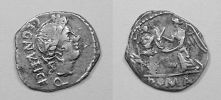
Republic Quinarius - 97 BC. - Mint of Rome
C. EGNATVLEIVS C. f.- Gens Egnatuleia
Ob.: Laureate head of Apollo right. C. EGNATVLEI C F (NAT & VL in monogram) behind. Q below
Rev. Victory inscribing shield on trophy. Q in central field. In ex. ROMA
Gs. 1,8 mm. 15,9x16,9
Craw. 333/1, Sear RCV 213
Maxentius
|
|

AR Denarius - L. MARCIVS PHILIPPVS - 113-112 BC. - Gens Îarcia - Mint of Rome
Obv.: Head of Philip V right wearing Macedonian helmet; ROMA monogram and simpulum behind, Φ forward
Rev.: Equestrian statue right, flower below horse; L. PHILIPPVS in a tablet. XVI (in monogram) in ex.
Gs. 3,6 mm. 18,3
Crawford 293/1; Sear RCV 170Maxentius
|
|

AR Denarius - TI. VETVRIVS - 137 BC. Gens Veturia - Mint of Rome
Obv.: Helmeted bust of Mars right, X and TI. VE (VE in monogram) behind
Rev.: Youth kneeling holding pig, between two soldiers; ROMA above
Gs. 3,6 mm. 18,3
Crawf. 234/1, Sear RCV 111
Some dies of this coin have a crude style. Maxentius
|
|

Denarius - C. FONTEIVS - Gens Fonteia - 114-113 BC - Mint of Rome
Obv.: Janiform head of the Dioscuri
Rev.: C FONT (NT in monogram), galley with pilot and three oarsman, ROMA in ex.
gs. 3,9 mm. 19,8
Cr290/1, Sear RCV 167.
Maxentius
|
|

Serrate Denarius - 106 BC
L. MEMMIVS GALERIA - Gens Memmia
Obv.: Laureate head of Saturn left; ROMA and harpa behind
Rev,; Venus in biga right, Cupid flying above with laurel wreath, L MEMMI (ME in monogram) GAL in two lines in ex.
Gs. 3,82 mm. 17,2x17,8
Cr313/1a, Sear RCV 190.
Maxentius
|
|

Serrate Denarius - 105 BC. - Mint of Rome
L. AVRELIVS COTTA - Gens Aurelia
Obv.: Draped bust of Vulcan right, in a laureate pileus, tongs & XVI (in monogram) behind, H ⢠before; all within a myrtle wreath
Rev.: Eagle standing right on thunderbolt, head left, L COT below; all within a laurel wreath.
Gs. 3,7 mm. 18,4
Cr314/1b; Sear RCV 191
Maxentius
|
|

Denarius - 109-108 BC.
Q. LVTATIVS CERCO - Gens Lutatia
Obv.: ROMA CERCO, helmeted head of Roma (or Mars) right. XVI in monogram behind
Rev.: Q LVTATI, galley right within oak wreath.
Gs. 3,7 mm. 17,4
Crawford 305/1, Sear RCV 182.
Maxentius
|
|

Denarius - 116/115 B.C.
CN. DOMITIVS, Q. CURTIVS, M. SILANVS - Gens Curtia
Obv.: Helmeted head of Rome right. X behind; Q. CVRT before
Rev.: Jupiter in quadriga right, holding thunderbolt. A lituus above; M. SILA (LA in monogram) below. In ex. ROMA
Gs. 3,8 mm. 19,3
Craw. 285/2, Sear RCV 162Maxentius
|
|

Denarius - 49 B.C.
L CORNELIVS LENTVLVS & C CLAVDIVS MARCELLVS - Gens Cornelia.
Obv.: Facing head of Medusa in center of triskeles, ear of corn between each leg
Rev.: Jupiter standing right with thunderbolt & eagle. LENT MAR (NT & MAR in monogram) left, COS right.
Gs. 3,5 mm. 18,4
Craw. 445/1b, Sear RCV 414.
Maxentius
|
|

AE As -169-158 BC (Grueber 196/173 BC)
VALERIVS - Gens Valeria
Obv.: Laureate head of Janus, I above.
Rev.:Ship's prow right, VAL in monogram above, I before, ROMA below.
Gs. 15,5 mm. 30,9
Craw. 191/1, Sear RCV 710, BMRCC 545. Maxentius
|
|

Denarius - 125 BC (Grueber 124/103 BC) - Mint of Rome
MN ACILIVS BALBVS - Gens Acilia
Obv.: Helmeted head of Roma right; XVI in monogram before, BALBVS behind, ROMA below, within laurel wreath
Rev.:Jupiter & Victory in quadriga right; Macedonian shield below the horses. In ex. MN (in monogram) ACILI
Gs. 3,8 mm. 18,4
Craw. 271/1, Sear RCV .147, BMRRC 1019
Maxentius
|
|

AE Quadrans - 134 BC. - Mint of Rome
C. ABVRIVS GEMINVS - Gens Aburia
Obv.: Head of Hercules right in lionskin, three pellets behind
Rev.: Prow of galley right. C. ABVRI (AB & VR in monogram) / GEM. three pellets before, ROMA below.
Gs. 4,3 mm. 17,6
Craw. 244/3, Sear RCV 1150, Grueber 1002Maxentius
|
|
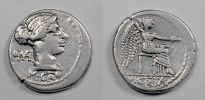
Denarius - 89 BC. - Mint of Rome
M. PORCIVS CATO - Gens Porcia
Obv.: Female bust right (Roma?). ROMA (MA in monogram) behind. M. CATO below
Rev.:Victoria seated right, holding palm and patera. In ex. VICTRIX (TR in monogram)
Gs. 3,8 mm. 17,7
Crawf. 343/1, Sear RCV 247, Grueber II 657
Maxentius
|
|

Denarius, 112/111 B.C. Rome Mint
CN. CORNELIVS CN.F. BLASIO - Gens Cornelia
Obv.:Mars, helmeted, right (or Scipio Africanus), CN. BLASIO CN.F. before (var. N retrograde), bucranium behind. XVI (in monogram) above
Rev.: Juno, Jupiter being crowned by Minerva; letter Î in field, ROMA in ex.
Gs. 3,25 mm. 20,6x18,4
Crawford 296/1c, Sear RCV 173, Grueber 626
Maxentius
|
|

Denarius - 147 BC. - Mint of Rome
C. TERENTIVS LVCANVS - Gens Terentia
Obv.: Helmeted head of Roma right, standing Victory and X behind
Rev.: Dioscuri galloping right, C. TER (TE in monogram) LVC below. In ex. ROMA in a tablet
Gs. 3,8 mm. 18,6.
Crawf. 217/1, Sear RCV 93, Grueber 775
Maxentius
|
|

Denarius - 130 BC. - Rome mint.
Q. CAECILIVS METELLVS - Gens Caecilia
Obv.: Helmeted head of Roma right; Q. METE (in monogram) behind, * below chin
Rev.: Jupiter with thunderbolt & branch walking in quadriga right. ROMA in exergue.
Gs. 3,9 mm. 21,38x18,86
Craw. 256/1, Sear RCV 132, Grueber 1053
Maxentius
|
|

Denarius - 109/108 BC. Rome mint.
MN. AQVILLIVS - Gens Aquillia
Obv.: Radiate head of Sol right. Before, X
Rev.: Luna (or Diana) in biga right; crescent moon and three stars above. Below, one star and MN (in monogram) AQVIL. In ex. ROMA
Gs. 3,7 mm. 18,81
Craw. 303/1, Sear RCV 180, Grueber II 645 Maxentius
|
|

Denarius - 103 BC.
Q. MINVCIVS M.f. THERMVS - Gens Minucia
Obv.:Helmeted head of Mars (or Rome) left
Rev.: Q. THERM (THE in monogram) M.F. (in monogram) below two warriors in combat, one on left protecting a fallen man.
Gs. 4 mm. 19,37x20,10
Crawf. 319/1, Sear RCV 197
Maxentius
|
|

Thracian Chersonese, Cherronesos AR Hemidrachm. 400-350 BC. Forepart of lion right, head turned back / quadripartite incuse with crested helmet, pellet and 'A' and 'E' monograms in parallel incuse squares.CANTANATRIX
|
|

Kallatis, Thrace, Circa 3rd-2nd Century BC. Ã 24mm. Laureate head of Apollo right / KA A - TIA NWN, tripod; grain ear in left field, magistrates name in ex. Moushmov 224, see http://www.wildwinds.com/coins/greece/thrace/kallatis/i.html for several different magistrates names/ monograms 60eAlexios
|
|

It is a copper lion of Mary Queen of Scots.
It is also known as a "hardhead", they were issued
1555-1560. It contains about 10% silver. they
were valued at three halfpence Scots, and were
equal in value to the french denier. The coin carries
the monogram FM, which appeared on her coinage
after her husband, the Dauphin, became Francis II
of France, on 10th July 1559. Francis died in 1560,
so this was issued within that period. Coin #633
cars100
|
|

Arados c. 240-237 BC
obverse : Turreted bust of Tyche right
reverse prow of galley left, with Athena figurehead, AP monogram above.Ginolerhino
|
|
|
|

Spain, New World Colonies under Philip II 1551-1555. Copper 8-Maravedis. Countermarked and obliterated monogram and castle on reverse.Castvlo
|
|
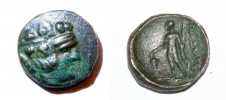
Maroneia, Thrace. 146-100BC, AE18mm.
Obv. Wreathed head of young Dionysos right. Rev. Dionysos left holding grapes, NARTHEX in right field, monogram in near left field.Lee S
|
|

Dänemark
Christian XI. 1863-1906
2 Ãre
1886
Münzstätte: Kopenhagen
Vs.: Gekröntes Monogramm
Rs.: Nominal flankiert von Delfin und Ãhre
Zitat: KM# 793.1
Erhaltung: Kratzer, ansonsten sehr schön - fast vorzüglich
Metall: Bronze
21 mm, 3,79 g _399Antonivs Protti
|
|

RDR -- Mecklenburg-Schwerin
Friedrich Franz II. (1842-1883)
Pfennig (Kupfer)
Münzstätte: Schwerin
Vs: Gekröntes Monogramm. Umschrift: "VGG GROSSH V MECKLENB SCHWERIN"
Rs: Wert, Jahreszahl und Münzzeichen (B).
Gewicht: 1,5g
Durchmesser: 15 mm
Erhaltung: sehr schön _397Antonivs Protti
|
|

Königreich Westfalen
Hieronymus Napoleon, 1807 - 1813
3 Cent 1809 C, Kassel
Monogramm aus HN im Kranz.
Rs: Landesbezeichnung, Wert, Mzz. und Jahr.
Erhaltung: Sehr schön
Durchmesser: 25 mm
Gewicht: 4,3 g _694Antonivs Protti
|
|

Byzantine glass coin weight
Monogram of Anastasius
20mm
5.72g
Bendall.64wileyc
|
|

Obv: Cruciform invocative monogram Type V; in the quarters: ÏÏ-cÏ|ÎϪ-λÏ; within wreath border (ÎεÏÏοκε βοήθει Ïá¿· Ïá¿· δοÏλῳ)
Rev: Quant.Geek
|
|

Trajan. à (11.50 g), AD 98-117. Laodicea ad Mare in Syria, CY 162 (AD 115/6). AYTOKP NEP TPAIANO? API?T KAI? ?EB ÃâEP ÃâAK àAP, laureate bust of Trajan right, slight drapery on far shoulder. Reverse: IOYÃâºI[EÃâ°N] TÃâ°N KAI [ÃâºAOÃâIKEÃâ°]N BÞP, turreted, veiled and draped bust of Tyche right; in right field, monogram. BMC 40; SNG Copenhagen 344; RPC 3796.2
Quant.Geek
|
|

Justin II AD 565-578. Constantinople
Pentanummium Ã
15mm., 2,68g.
Monogram of Justin and Sophia / Large E, B to right.
good very fine
Sear 363.
Quant.Geek
|
|

Justinian I. AD 527-565. Rome
Denarius AE
8mm., 1,60g.
Justinian monogram / Diademed, draped, and cuirassed bust right.
fine
DOC 372 (Uncertain mint; nummus); Morello 19/1 (Ravenna[?]; 2½ nummi); MIBE 94; SB 340 (Uncertain mint; nummus); BMC Vandals 140 (Vandalic).
Quant.Geek
|
|

THRACE, Odessos. Circa 280-225 BC. AR Tetradrachm (26mm, 16.44 g, 11h). In the name and types of Alexander III of Macedonia. Head of Herakles right, wearing lion skin / Zeus Aëtophoros seated left; in left field, monogram above civic monogram. Topalov, Odesos 23; Price 1151; HGC 3.2, 1584. Quant.Geek
|
|

MOEDA - 500 Réis - 1938 - Regente Feijó
________________________________________
Série Ilustres
Excelente estado de conservação
ANVERSO
O busto do Regente do Império Diogo António Feijó circundado pela inscrição REGENTE FEIJÃ. Em baixo, monograma do gravador Calmon Barreto.
REVERSO
No centro, uma coluna corÃntia encimada pela inscrição circular BRASIL entre dois filetes. à esquerda do campo, o valor 500 e, à direita, a palavra RÃIS em posição horizontal. No exergo, a data e, ao lado direito, a sigla do gravador Walter Toledo.
PADRÃO MONETÃRIO
MIL-RÃIS (de 08/10/1833 a 31/10/1942)
PERÃODO POLÃTICO
República, Era Vargas (1930-1945)
ORIGEM
Casa da Moeda, Rio de Janeiro
CARACTERÃSTICAS
Material: bronze alumÃnio
Diâmetro: 22,5 mm
Peso: 5,00 g
Espessura: 1,80 mm
Bordo: serrilhado
Titulagem: Cu 910, Al 90
Eixo: reverso medalha (EV)
_____________________Antonivs Protti
|
|
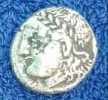
KYRENAICA. Kyrene. AR Didrachm (7.69 gms), ca. 305-300 B.C. CHOICE VERY FINE. SNG Cop-1238; BMC-238. Obverse: Head Zeus Karneios left; Reverse: Silphium plant; monogram to left, star to right. Though rather intensely cleaned, this piece nevertheless offers a solid strike and a pleasing representation of the silphium plant--harvested to extinction in antiquity.
|
|

Obv: Crowned and cuirassed bust facing, holding globus cruciger
Rev: Large M; monogram above; to left and right, Heraclius and Tiberius standing facing, holding globus cruciger
Dim: 27 mm, 2.96 g
Quant.Geek
|
|

Ancient Greece
Troas: Kebren
BC 412-399
Obverse: Satrap head left
Reverse: KE monogram
9mm 0.66 grams
SNG vAUL-1547paul1888
|
|

BAΣIÎEΩΣ ΣΩTHPOΣ-MENANÎPOY, diademed and draped bust of Menander right, seen from front / Maharajasa tratasara Menandrasa (Kharosthi script), Athena Alkidemos striding left, shield on left arm, hurling thunderbolt in right; HÎΩ monogram to left. HGC 12, 191. Bopearachchi 13Q. SNG ANS 822-41. Quant.Geek
|
|

INDO-SCYTHIAN KINGDOM. Azes I/II (ca. 58-12 BC). AE hexachalkon or tetradrachm (27mm, 13.51 gm, 1h). Uncertain mint in western Gandhara. BAΣIÎEΩΣ BAΣIÎEΩN MEÎAÎOY AZOY, Bull standing right; monogram above; Kharosthi letter to right / Maharajasa rajarajasa mahatasa Ayasa (Kharosthi), lion standing right; monogram above. Quant.Geek
|
|

INDO-SKYTHIANS. Azes, circa 58-12 BC. Tetradrachm (Bronze, 22 mm, 7.60 g, 5 h), Indian standard, uncertain mint in Gandhara. BAΣIÎEΩΣ BAΣIÎEΩN MEÎAÎOY / AZOY King on horseback to right, raising his right hand and holding whip in his left; to right, Kharoshthi letter. Rev. 'Maharajasa rajarajasa mahatasa Ayasa' ('of Great King, King of Kings Azes the Great' in Kharoshthi Zeus standing front, head to left, holding Nike in his right hand and scepter in his left; to left, monogram and Kharoshthi letter; to right, Kharoshthi letters. HGC 12, 639. Senior, type 105. Some cleaning scratches, otherwise, very fine.
Quant.Geek
|
|

ISLANDS off THRACE, Thasos. Circa 90-75 BC. AR Tetradrachm (31mm, 16.63 g, 12h). âImitativeâ series. Head of young Dionysos right, wearing ivy wreath / Herakles standing facing, head left, holding club in right hand, lion skin draped over left arm; monogram to inner left. Prokopov, Silberprägung, Group XII, 633 (V AC1/R 518); Le Rider, Thasiennes 52; HGC 6, 359. Toned, light deposits. VF.
From the Don T. Hayes Collection.
CNG 546 lot 56.Britanikus
|
|

Sicily, Syracuse, Agathocles (317-289 BC), Silver Tetradrachm, struck c.310-305 BC.
Obv/ Head of nymph Arethusa facing left, her hair wreathed with grain, wearing a triple-pendant earring and a pearl necklace, three dolphins swimming around, NK below neck.
Rev/ ΣYPAKOΣIΩN (in exergue); charioteer, wearing a long chiton and holding a kentron (goad) in his right hand and the reins on his left, driving a fast quadriga left, triskeles above, AI monogram in exergue off flan.paul1888
|
|

JUSTINIAN I, AR Siliqua or Half-Siliqua, struck 537 - 552 at CarthageObverse: D N IVSTINIANVS P P AV. Diademed, draped and cuirassed bust of Justinian I facing right.
Reverse: Monogram, cross above, S below, within circle, all encircled by wreath. (SBCV Monogram 3)

Diameter: 13mm | Weight: 1.17gms | Die Axis: 6
SBCV: 254 (Siliqua) | Sommer 4.119
Scratched obverse. Not in DOC.
RARE
The monogram on the reverse of this coin was originally interpreted as being that of the Ostrogothic queen Mathasunta (cf. BMC 80, 1). However, a later re-interpretation by Wolfgang Hahn (MIB) attributed this issue as being a regular African Imperial issue of Justinian, and this is the attribution that was adopted by SBCV.
On September the 15th 533 Justinian's army, led by Belisarius, entered the city of Carthage and brought it back into the Roman Empire after 98 years of Vandal rule. In March 534 the Vandal king Gelimer surrendered to Belisarius ending the Vandal kingdom and returning the African provinces to the empire. Large numbers of captured Vandals were transported to Constantinople and in April Belisarius returned there too and was permitted by Justinian I to celebrate a triumph, the first non-imperial triumph for over 500 years.*Alex
|
|
|

5 Claudius and AgrippinaCLAUDIUS AND AGRIPPINA
à As, Bosporus (23mm, 6g)
Minted circa 50â54 AD by King Kotys I (46 â 63 AD)
TI KLAVDIOV KAICAPOC; Head of Claudius r.; "IB" below / IOVLIAN AGRIPPINAN CEBACTHN; Head of Agrippina l.; monogram "BAK" in field to l.
Anokhin # 348
RI0025Sosius
|
|

Alexander the Great, 336 - 323 BC. AE Hemiobol (4 Chalkoi). Struck 336 - 320 BC, possibly under Philip III at Miletus in Macedonia.Obverse: No legend. Head of Alexander the Great as Herakles, wearing lion-skin knotted at base of neck, facing right.
Reverse: AÎEÎANÎâ¢POY. Bow in Gorytos (a case for bow and quiver) above, club below. ΠΥΡ monogram control mark below club
Diameter: 18mm | Weight: 5.79gms | Die Axis: 3
Price: 0335
Alexander the Great reigned from 336 to 323 BC. Price supposes this coin to be a lifetime issue and Sear concurs stating that the issues that are more likely to be posthumous are the ones bearing the title BAΣIÎEOΣ. Thompson however, has proposed a posthumous date of 321 - 320 BC (Thompson series IV) based on the compound ΠΥΡ monogram used as a control mark.
It is difficult to interpret the die orientation in these issues because not only is it unclear what the Ancient Greeks would have considered "up" with respect to the reverse design but modern scholars are ambiguous on the subject as well. I have, however, assumed that the modern conventional orientation is with the name reading horizontally, and therefore have described my example as having a 3 o'clock orientation, the "top" of the reverse being aligned with the back of Herakles' head on the obverse.
*Alex
|
|

JUSTINIAN I, AE 16 Nummi, struck 527 â 562 at ThessalonicaObverse: D N IVSTINIANVS P P AVG. Diademed, draped and cuirassed bust of Justinian I facing right.
Reverse: Large AISP; chi-rho monogram above âIâ; TÐS in exergue below.
Diameter: 23mm | Weight: 5.92gms | Die Axis: 6
SBCV: 178 | DOC: 98d.5
Regarding the letters AISP on the reverse of this coin, it is generally accepted that the "IS" of the inscription equates to "10+6" = "16", a denomination used only at Thessalonica. However the meaning of the letters A and P is still uncertain despite having been the subject of much scholarly debate.
*Alex
|
|

Philip III Arrhidaios, 323 - 317 BC. Bronze Tetartemorion (Dichalkon / Quarter Obol). Struck 323 - 315 BC under Nikokreon at Salamis, Cyprus.Obverse: No legend. Macedonian shield with Gorgoneion (Medusa) head as the boss in the centre. The shield boss is sometimes called the episema, the Greek name for a symbol of a particular city or clan which was placed in the centre of a soldier's shield.
Reverse: Macedonian helmet surmounted with a horse hair crest; B - A (for BAΣIÎEOΣ AÎEÎANÎPOY = King Alexander) above; mint marks below the helmet, to left, a kerykeion (caduceus) and to the right, the monogram NK (for Nikokreon).
Diameter: 14mm | Weight: 4.6gms | Die Axis: 1
Price: 3162 | Liampi, Chronologie 170-92
This coin is a Type 7 (Macedonian shield type) bronze Quarter-Obol (two chalkoi). Price dated the Macedonian Shield coins as beginning during the latter part of Alexander's life, c.325 BC, and ending c.310 BC. Liampi later argued, based on new hoard evidence, that they were minted as early as 334 BC. This particular coin is dated from c.323 to 315 BC during the reign of Philip III Arrhidaios.
Salamis was founded around 1100 BC by the inhabitants of Enkomi, a Late Bronze Age city on Cyprus, though in Homeric tradition, the city was established by Teucer, one of the Greek princes who fought in the Trojan War. After Alexander the Great conquered the Persian Empire, of which Salamis was a part, Greek culture and art flourished in the city and, as well as being the seat of the governor of Cyprus, it was the island's most important port.
Nikokreon had succeeded Pnytagoras on the throne of Salamis and is reported to have paid homage to Alexander after the conqueror's return from Egypt to Tyre in 331 BC. After Alexander's death, his empire was split between his generals, Cyprus falling to Ptolomy I of Egypt. In 315 BC during the war between Antigonos and Ptolemy, Nikokreon supported the latter and was rewarded by being made governor of all Cyprus. However, in 311 BC Ptolemy forced Nikokreon to commit suicide because he no longer trusted him. Ptolemy's brother, King Menelaus, was made governor in Nikokreon's stead.
In 306 BC, Salamis was the scene of a naval battle between the fleets of Ptolemy and Demetrius I of Macedon. Demetrius won the battle and captured the island. *Alex
|
|

10 Vespasian AR EphesusVespasian
AR Denarius.
Ephesus Mint,
71 AD.
O: IMP CAESAR VESPAS AVG COS III TR P P P, laureate head right
R: LIBERI IMP AVG VESPAS, Titus & Domitian standing, heads left, each holding a patera, EPHE monogram in ex.
RIC 1430c, RSC 250, RPC 832, sear5 #2401
RI0064Sosius
|
|

4Obverse
PHILIPPVS monogram
Crowned 1642
Date in cartouche?
Reverse
REX monogram
XII over ?
?mauseus
|
|

4. AthalaricAnatomy of a Monogram of Athalaric
BMC Ostrogoths p. 67, 52Sosius
|
|
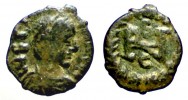
4. Athalaric, in name of JustinianATHALARIC
Ostrogoth King of Rome, in name of Justinian
AE 4, Ravenna mint
O: IVSTI..., diademed and cuirassed bust of Justinian I right
R: Monogram of Athalaric in wreath
BMC Ostrogoths p. 67, 52
Sosius
|
|

5Obverse
PHILIPPVS monogram
Crowned date (unclear, 1641?)
Cartouche date (unclear)
Reverse
REX monogram
Cartouche 8
VIII over MDmauseus
|
|

9Obverse
PHILIPPVS monogram
VIII over TO monogram
?
Reverse
REX monogram
Crowned 1641mauseus
|
|

AE AE Pentanummium Justin II SB 363Obverse: Monogram 8
Reverse: Large E, officina delta to r.
Date: 565-548 CE
Sear 363 DO 60a-d
12mm 2.82gm
wileyc
|
|
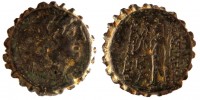
Alexander I, BalasSerrated AE 21, Syria, Alexander I Balas, Obv: Alexander right. Rev: ÎÎΣÎÎÎΩΣ ÎÎÎÎÎÎÎΡÎÎ¥;, Athena with Nike, monograms, aVF. Lindgren III, pl. 62, 1074, Hoover HGC 9, 900 (R1-2).Molinari
|
|

Amisos, Pontos, c. 85 - 65 B.C. Mithradates VI Eupator. Obv. aegis with facing head of Medusa (gorgoneion) in center; Rev. AMIâΣOY, Nike advancing right, holding palm frond across shoulders behind, AâT monogram lower left.
19.7mm, 8.4 grams.
References: Sear 3642, BMC 72.Canaan
|
|

Antiochos IX, KyzikenosAE 18, Syria, Antiochos IX, ca. 116-95 B.C. Obv: Head of bearded Herakles facing right. Rev: ÎÎΣÎÎÎΩΣ ÎÎΤÎÎÎÎÎ¥ ΦÎÎÎ Î ÎΤΡÎÎ¥ around Athena standing left, holding Nike, monogram and aplustre in field. Black patina, gF. Lindgren I, 1867, SC 1250, Hoover HGC 9, 1250 (S).Molinari
|
|

Antiochos VIII Epiphanes, Sole reign, 121/0-97/6 B.C. AR Tetradrachm (28mm, 16.32g). Damascus, S.E. 197 (116/5 B.C.).Antiochos VIII Epiphanes, Sole reign, 121/0-97/6 B.C. AR Tetradrachm (28mm, 16.32g). Damascus, S.E. 197 (116/5 B.C.). Diademed head of Antiochos VIII right; fillet border. Rv. Zeus Uranios standing left, draped, holding star and scepter; in outer left field, two monograms; in exergue, date (ZPP); laurel wreath border. SC 2323.5a. LSM 101. Ex Coin Galleries 11-8-2000, lot 129. Ex Eukratides 2021.
Photo Credits: EukratidesJustin W
|
|

ApameiaAE 20, Syria, Apamea, 30/29 BC. Obv: Dionysus facing right, ME monogram behind. Rev: Thyrsos surrounded by ÎÎ ÎÎÎΩΠTHΣ EIPAΣ KAI AΣYÎOY, Seleukid era date ÎΠΣ (30/29 BC). aF. RPC I, 4347-4352, Hoover HGC 9, 1425 (S).Molinari
|
|

Apollonia - Ceka 115.Illyria, Apollonia After 229 BC
AR Drachm.
TIMHN, Cow standing left, looking back at suckling calf, Gamma AK monogram below.
APOL DAMOFWNTOS around square with double stellate pattern. xokleng
|
|

Baktrian Kingdom, Diodotos I, ca. 255/250-240 BC, AR Tetradrachm Diademed head of Diodotos I right.
ÎÎΣÎÎÎΩΣ ANTIOXOY Zeus advancing left hurling thunderbolt, eagle at feet, ÎÎΤ (Iota, Delta, Sampi) monogram in inner left field.
Holt A6.4 (this coin); Kritt A6 (plate 2 A6 this coin); CSE 1294 (this coin); SNG Lockett 3109 (this coin ID: SNGuk_0300_3109); Pozzi 2945 (this coin); ESM 717α (this coin); SNG ANS 77; SC 631.a; Bopearachchi 2E; Mitchiner 64d; Qunduz 6; HGC 9, 243.
Mint "A" - Ai Khanoum
(26 mm, 15.73 g, 6h).
Herakles Numismatics; ex- Houghton Collection (CSE 1294); ex- Lockett Collection (SNGLockett 3109); ex- Pozzi Collection: Naville Sale I (1921) 2945 (sold for CHF 35).
This coin has a very distinguished provenance and has been published as plate coin in four reference works.
The emission with the ÎÎΤ (Iota, Delta Sampi) mint control mark is the most abundant of the Diodotid issues, representing about 13% of known Diodotid precious metal coins. The same control carries over into the early coinage of Euthydemos, although eventually displaced by the PK control monogram after 208/6 BC when Antiochos III captured Ai Khanoum while Euthydemos remained besieged at Baktra, after which it appears that Baktra/Balkh assumed the role of primary royal mint in Baktria. In is notable that the Archaic Greek letter Sampi forms the bottom of the ÎÎΤ monogram. It is an Archaic Greek form of a double Sigma that persisted in Greek dialects of Asia Minor. Many Greek settlers from Asia Minor migrated to Baktria, including the illustrious ruler Euthydemos from Magnesia in either Lydia, or Ionia. The archaic Greek Sampi possibly traveled to Baktria with the earliest Greek settlers from Asia Minor.
n.igma
|
|

CILICIA, Mallos. 2nd-1st centuries BC. Ã Coin #644CILICIA, Mallos. 2nd-1st centuries BC. Ã (22mm, 10.88 g, 12h).
Head of Apollo right / Athena seated left, holding Nike and spear; monogram to left.
SNG France -; SNG Levante -; SNG Levante Supp. -; SNG Pfalzer -; BMC 29. VF, brown patina. Scarce.
Coin #644
cars100
|
|

Demetrios II Nikator, Second reign, 129-125 BC. Silver tetradrachm. Tyre.Obv: Diademed head of king right.
Rev: Eagle standing on prow left, with palm branch, club surmounted by monogram and monogram in inner left field, two monograms in inner right field, monogram between legs.
References: SC 2195.5b. Newell 179. Hoover 1122.
28 mm, 13,23 g.Canaan
|
|

Enniscorthy (Wexford) copper halfpenny token dated 1800.Woodcock's Bank Enniscorthy (Wexford) copper halfpenny token dated 1800. Obverse: View of a castle by the sea with a portcullis formed by six vertical and one horizontal bar in the gateway and legend: "PAYABLE AT THE BANK OF R. W. ENNISCORTHY". Reverse: Shield with monogram "RW" hanging from the bough of a tree with hills and a castle in the background: "A. D. 1800". Plain edge. The issuer, R. Woodcock was a banker at Enniscorthy. The reverse design depicting "Vinegar Hill" refers to a tragedy there two years before the issue of the coin when there was an uprising of the United Irishmen in Dublin. This was soon suppressed, however, the peasants in the south followed suite and also revolted. Armed with fowling pieces, French muskets and long pikes, they captured several towns including Enniscorthy and Wexford. The rebels then organised a training camp for their 6,000 strong force on Vinegar Hill. In June, General Lake attacked the Vinegar Hill camp and routed the half-trained force and, with Major-General John Mooreâs recapture of Wexford, the rebellion disintegrated. The bodies of around 500 men who were killed in the battle lie buried in a mass grave at the foot of the hill. D&H Wexford No: 4. Diameter 28.8mm.Ancient Aussie
|
|

JUSTINIAN I, AE Pentanummium (5 Nummi), struck 527 â 565 at ChersonObverse: D N IVSTINIANVS P P AG. Diademed, draped and cuirassed bust of Justinian I facing right.
Reverse: Monogram of Cherson within wreath or foliated circle. (SBCV Monogram 1)

Diameter: 16mm | Weight: 1.8gms | Die Axis: 6
SBCV: 197 | DOC: 108.2
Cherson (in Greek it was spelt with a Chi) was a Byzantine military trading site located in the southern Crimea, centred at Chersonesus Taurica. Ancient Cherson was located near where Sevastopol is now, on the peninsula projecting into the north side of the Black Sea, but parts of the ruins of the city are now under water. Ancient Cherson was destroyed by the Mongols/Tartars in the 13th century and should not be confused with the modern city of Cherson which was not founded until 1779.
*Alex
|
|
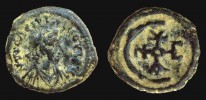
JUSTINIAN I, AE Pentanummium (5 Nummi), struck 560 â 565 at Antioch (Theoupolis)Obverse: "D N IVSTINIANVS P P AVG" (badly blundered legend as is usual for this type). Diademed, draped and cuirassed bust of Justinian I facing right.
Reverse: Large C enclosing complex monogram of Antioch forming a cross, all within circle (SBCV Monogram 2)

Diameter: 16mm | Weight: 2.5gms | Die Axis: 12
SBCV: 245 | DOC: 272.1
Much of Antioch was destroyed by a great earthquake on 29th November 528 and, following this disaster, the city was renamed Theoupolis.
*Alex
|
|

Kingdom of Bithynia. Prusias IIAE22, 4.85 grams
228-149 BC.
Head of Dionysos right, wearing ivy-wreath
ÃâÃâÃâÃâ¢ÃâºÃâ¢Ã©Ã£ àáßYãÃâ¢ÃŸÃÂ¥, centaur Chiron walking right, playing lyre, monogram beneath leg
HGC 7, 629; Rec gén 26;
JBGood
|
|

Kings of Macedon: Antigonos I struck under Demetrios I Poliorketes, AE15 Half Unit.Salamis 320-301 B.C. 3.42g - 15.5mm, Axis 12h.
Obv: Macedonian shield, boss decorated with facing gorgoneion.
Rev: Macedonian helmet, kerykeion and monogram to lower left and right.
Ref: Price 3159 (c. 323-315 BC) var. (Unit); Zapiti & Michaelidou 7-8 var. (same).
Provenance: Ex Derek Glover. Chris Scarlioli CollectionChristian Scarlioli
|
|

L SaufeiusHelmeted head of Roma right X behind
Victory in biga right L SAVF VF in monogram
ROMA below
Rome, 152 BC
3.54g
Sear 83, Saufeia 1, Syd 384
SOLD! Forum Auction July 2020Jay GT4
|
|

Macedon,Alexander III. AR tetradrachmprice 1679 / Themnos mint /188-170BC
obv: head of Herakles r. wearing lion-skin
rev: Zeus Aetophoros seated l. M l. in field. monograms
above oinoche withen vine tendril,eagle and sceptrehill132
|
|

Macedonia, Alexander III, Ar drachmPrice 1382 / 310-301 BC
obv: Head of young Heraclea r. wearing lion-skin headdress
rev: ALEXANDROU Zues enthrond l. holding eagle and scepter forpart of
Pegasus l. monogram NO below thronehill132
|
|

Macedonian Kingdom, Philip II, Father of Alexander the Great 359-336 BCEBronze AE Unit, SNG ANS 934, nice VF, Macedonian mint, 6.328g,
17.4mm, 0°, c. 359 - 336 B.C.E.
Obverse: head Apollo right wearing taenia.
Reverse: æIÃâºIààOÃÂ¥, young male rider
atop horse prancing to right, LO monogram below.
18.0 mm, 7.01 g.
Philip II expanded the size and influence of the Macedonian Kingdom,
but is perhaps best known as the father of Alexander the Great.
He personally selected the design of his coins.NORMAN K
|
|

Manuel I Komnenus AE half tetarteron Reverse: MAN(monogram)HA AECIIOTH or similar Manuel bearded facing wearing crown and miltary attire and holding cruciform sceotre and gl. cr.
Mint: Unk greek mint
Date: 1143-1180 CE
Sear 1981 H. 18.5-6 (as Sear 1978 but smaller)
14mm 1.86wileyc
|
|

Manuel I Komnenus clipped billion aspron trachy SB1966Obverse: IC-XC (bar above) in field, Christ bearded and nimbate, wearing tunic and colobion, seated upon throne without back; holds gospels in left hand.
Reverse: MAN(monogram)HA AECIIOT or var, MP OV bar above in upper right field, Full-length figure of emperor, bearded on left, crowned by Virgin nimbate. Emperor wears stemma, divitision, collar-peice, and jewelled loros of simplified type; holds in right hand labarum-headed scepter, and in left globus cruciger. Virgin wears tunic and maphorion.
four main varieties:
Mint: Constantinople
Date: 1167-1183?
Sear 1966 Var d, Fourth coinage; H 16.14,15; 17.1-4
rev: Jewel within circle on loros waist
16mm .89gm
As discussed in the Byzantine forumThese are the "neatly clipped" trachies.
During the reign of Manuel I the silver content of the trachy was dropped from c.6% to c.3%, but later types were sometimes issued with the higher silver content.
In Alexius III's time these high silver types were clipped down to half size, probably officially, presumably so as to match the lower silver content of the later issues.
Of course this would only have worked as long as the populace accepted the idea that the clipped coins were all high silver versions to start with. Once smarties started clipping ordinary coins these types would soon have have fallen out of favour and been withdrawn.
Ross G.
During the reign of Alexius III were reused coins of previous releases, clipping its border in a very regular mode and thus reducing to half their weight. Regularity of shearing and the fact that they were found to stock uniforms, suggesting that this clipping is a formal issuance of mint. Based on the stocks found in Constantinople , some of which consist only of clipped coins, it may safely be dated between 1195 and 1203.
Hendy and Grierson believe that this shearing was a consequence of the devaluation of trachy mixture during the reign of Isaac II and Alexius III. They reduced by half the already low silver content of this coin: shearing coins of previous emperors, still widely in circulation, made their trachy consistent with the intrinsic value of current emissions. Of course, this does not justify the clipping of coins already degraded of Isaac II and Alexius III. Therefore, reason for their declassification is not understood. I think that reason of Ross is right!
The structure of their dispersion in hoards indicates that, however, were made after the other emissions. Clipped trachys appear in small amounts along with regular trachy in hoards, represents a rarity. Were clipped trachys of Manuel I, Andronicus I, Isaac II and Alexius III, and perhaps of John II; those of Manuel are less scarce. In principle, we must believe that all trachys after Manuel I have been clipped, although many have not yet appeared.
Antvwala
wileyc
|
|
| 4889 files on 55 page(s) |
1 |
 |
 |
 |
 |
|

|
